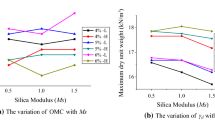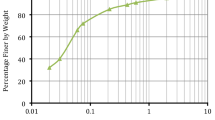Abstract
Depletion of natural aggregates due to extensive use for road construction has triggered the scope of implementing non-conventional materials. The utilization of treated native soil in the subbase course of flexible pavement can largely reduce the consumption of natural aggregates and overall construction cost. The primary objective of this study is to investigate the feasibility of using slag–lime-treated native soil in the subbase course of flexible pavement. Ground granulated blast furnace slag (GGBS) alone, as well as in combination with lime, was intended to stabilize the expansive native soil which poses sizeable complications during the construction and maintenance of road pavements due to its poor strength and high swelling–shrinkage characteristics. The native soil was treated with GGBS (G) at 3, 6, 9 and 12% and GGBS + lime (G + L) at 2 + 1, 4 + 2, 6 + 3 and 8 + 4% by weight of dry soil. On the basis of California bearing ratio (CBR) and unconfined compressive strength tests, native soil treated with 12% G, 6% G + 3% L and 8% G + 4% L bettered the minimum requirement for subbase material based on IRC criteria. In order to assess the service life ratio of flexible pavement constructed with slag–lime-treated native soil as a subbase on the basis of fatigue as well as rutting criteria, finite element analysis using PLAXIS 3D was performed on the pavement crust over the subgrade of 4% CBR for a traffic intensity of 100 million standard axles. Finally, design charts of equivalent thickness of slag–lime-treated expansive soil in relation to conventional granular subbase (GSB) were developed to derive the cost efficiency of utilizing stabilized native soil as a potential alternative for conventional GSB. Pavement with slag–lime-treated native soil in subbase layer exhibited residual life of up to 65% more than that of conventional pavement, subsequently reducing the overall construction cost by 15.5%.









Similar content being viewed by others
References
World Steel Association (2020) Global crude steel output in 2019. Accessed 4 Feb 2020. https://www.worldsteel.org/
Cokca E, Yazici V, Ozaydin V (2008) Stabilization of expansive clays using granulated blast furnace slag (GBFS) and GBFS-cement. Geotech Geol Eng 27:489–499
Sharma AK, Sivapullaiah PV (2012) Improvement of strength of expansive soil with waste granulated blast furnace slag. Proc GeoCongr ASCE Calif. https://doi.org/10.1061/9780784412121
Laxmikanth Y, Tripathi RK (2012) Effects of granulated blast furnace slag in the engineering behaviour of stabilized soft soil. In: Proceedings of 3rd Nirma University international conference on engineering, Ahmedabad
Veith GH (2000) Engineering properties of sulphate-bearing clay soils stabilised with lime activated GGBS. Ph.D. Dissertation. University of Glamorgan, United Kingdom
Veith G, Wild S, Robinson RB (1999) Shear strength, permeability, and porosity of Kimmeridge clay, stabilised with lime and ground granulated blast furnace slag. In: Proceedings of concrete communications conference, Cardiff University, British Cement Association, pp 41–52
Patel S, Shahu JT (2015) Engineering properties of black cotton soil-dolime mix for its use as subbase material in pavements. Int J Geomate 8(1):1159–1166
Patel S, Shahu JT (2018) Comparison of industrial waste mixtures for use in subbase course of flexible pavements. J Mater Civ Eng 30(7):04018124. https://doi.org/10.1061/(ASCE)MT.1943-5533.0002320
Kamon M, Nontananandh S (1991) Combining industrial wastes with lime for soil stabilization. J Geotech Eng ASCE 117(1):1–17
Kamon M, Nontananandh S, Katsumi T (1993) Utilization of stainless-steel slag by cement hardening. Soils Found 33(3):118–129
Sherwood PT (1993) Soil stabilisation with cement and lime (State of the art review). HMSO Publication, London
Britpave (British In-situ Concrete Paving Association) (2004) Stabilised Soils as subbase or base for roads and other pavements. BP/08, Camberley
Fulton FS (1974) The properties of Portland cements containing milled granulated blast furnace slag. The Portland Cement Institute, Johannesburg, pp 4–46
Dyer CD (1982) Road construction technology in South Africa. Juta and Company, Cape Town
Sargent P, Hughes PN, Rouainia M, Glendinning S (2012) Soil stabilization using sustainable industrial by-product binders and alkali activation. Proc GeoCongress ASCE Calif. https://doi.org/10.1061/9780784412121
Wild S, Kinuthia JM, Robinson RB, Humphreys I (1996) Effects of ground granulated blast furnace slag (GGBS) on strength and swelling properties of lime stabilised kaolinite in the presence of sulphates. Clay Miner 31(3):423–433
Wild S, Kinuthia JM, Jones GI, Higgins DD (1998) Effects of partial substitution of lime with ground granulated blast furnace slag (GGBS) on the strength properties of lime stabilised sulphate-bearing clay soils. Eng Geol 51(1):37–53
Wild S, Kinuthia JM, Jones GI, Higgins DD (1999) Suppression of swelling associated with ettringite formation in lime stabilized sulphate bearing clay soils by partial substitution of lime with granulated blast furnace slag. Eng Geol 51(4):257–277
Rao AS, Sridevi G (2011) Utilization of industrial wastes in pavements laid over expansive clay subgrades. Proc GeoFrontiers ASCE Texas. https://doi.org/10.1061/9780784411650
James R, Kamruzzaman HM, Haque A, Wilkinson A (2008) A Behaviour of lime-slag-treated clay. Proc Inst Civ Eng Ground Improv 161(4):207–216
Yi Y, Liska M, Al-Tabbaa A (2014) Properties of two model soils stabilized with different blends and contents of GGBS, MgO, lime, and PC. J Mater Civ Eng ASCE 26(2):267–274. https://doi.org/10.1061/(ASCE)MT.1943-5533.0000806
Yi Y, Li C, Liu S (2014) Alkali-activated ground-granulated blast furnace slag for stabilization of marine soft clay. J Mater Civ Eng ASCE 27(4):1–7. https://doi.org/10.1061/(ASCE)MT.1943-5533.0001100
Islam S, Haque A, Wilson SA (2014) Effect of curing environment on the strength and mineralogy of lime-GGBS treated acid sulphate soils. J Mater Civ Eng ASCE 26(5):1003–1008. https://doi.org/10.1061/(ASCE)MT.1943-5533.0000887
Islam S, Haque A, Wilson SA, Ranjith PG (2015) Time-dependent strength and mineralogy of lime-GGBS treated naturally occurring acid sulfate soils. J Mater Civ Eng ASCE 28(1):1–9. https://doi.org/10.1061/(ASCE)MT.1943-5533.0001333
Shahu JT, Patel S, Senapati A (2012) Engineering properties of copper slag–fly ash–dolime mixture and its utilization in the base course of flexible pavements. J Mater Civ Eng ASCE 25(12):1871–1879. https://doi.org/10.1061/(ASCE)MT.1943-5533.0000756
Patel S, Shahu JT (2016) Resilient response and permanent strain of steel slag-fly ash-dolime mix. J Mater Civ Eng ASCE 28(10):1–11. https://doi.org/10.1061/(ASCE)MT.1943-5533.0001619
Patel S, Shahu JT (2017) Comparative study of slags stabilized with fly ash and dolime for utilization in base course. J Mater Civ Eng 29(10):04017168. https://doi.org/10.1061/(ASCE)MT.1943-5533.0002017
Bakare MD, Pai RR, Patel S, Shahu JT (2019) Environmental sustainability by bulk utilization of fly ash and GBFS as road subbase materials. J Hazard Toxic Radioact Waste 23(4):1–10. https://doi.org/10.1061/(ASCE)HZ.2153-5515.0000450
IRC (Indian Road Congress) (2002) Rural roads manual. IRC SP 20, New Delhi
BIS (Bureau of Indian Standards) (2015) Determination of water content-dry density relation using heavy compaction. IS 2720 Part VIII, New Delhi
BIS (Bureau of Indian Standards) (2015) Determination of unconfined compressive strength of stabilized soils. IS 4332 Part V, New Delhi
BIS (Bureau of Indian Standards) (2011) Laboratory determination of CBR. IS 2720 Part XVI, New Delhi
IRC (Indian Road Congress) (1992) Guidelines for the use of soil-lime mixes in road construction. IRC 51, New Delhi
Dash SK, Hussain M (2012) Lime stabilization of soils: reappraisal. J Mater Civ Eng 24(6):707–714. https://doi.org/10.1061/(ASCE)MT.1943-5533.0000431
Prakash K, Sridharan A (2012) Classification of non-plastic soils. Indian Geotech J 42:118–123. https://doi.org/10.1007/s40098-012-0007-5
Hausmann MR (1990) Engineering principles of ground modification. McGraw-Hill, Singapore
Solanki P, Khoury N, Zaman MM (2009) Engineering properties and moisture susceptibility of silty clay stabilized with lime, class C fly ash, and cement kiln dust. J Mater Civ Eng 29(12):749–757. https://doi.org/10.1061/(ASCE)0899-1561(2009)21:12(749)
Dallas NL (1999) Evaluation of structural properties of lime stabilized soils and aggregates. National Lime Association, Virginia
IRC (Indian Road Congress) (2012) Guidelines for the design of flexible pavements. IRC 37, New Delhi
MORTH (Ministry of Road Transport and Highways) (2013) Specifications for road and bridge works (5th revision). Indian Road Congress, New Delhi
Huang YH (2004) Pavement analysis and design, 2nd edn. Pearson Prentice Hall, Upper Saddle River
Tanyu BF, Kim WH, Edil TB, Benson CH (2003) Comparison of laboratory resilient modulus with back-calculated elastic moduli from large-scale model experiments and FWD tests on granular materials. In: Resilient modulus testing for pavement components. ASTM STP 1437, West Conshohocken, PA: ASTM, pp 191–208
AASHTO (American Association of State Highway and Transportation Officials) (1993) Guide for design of pavement structures. Transportation Research Board, National Research Council, Washington, DC
Author information
Authors and Affiliations
Corresponding author
Additional information
Publisher's Note
Springer Nature remains neutral with regard to jurisdictional claims in published maps and institutional affiliations.
Rights and permissions
About this article
Cite this article
Pai, R.R., Patel, S. & Bakare, M.D. Applicability of Utilizing Stabilized Native Soil as a Subbase Course in Flexible Pavement. Indian Geotech J 50, 289–299 (2020). https://doi.org/10.1007/s40098-020-00432-4
Received:
Accepted:
Published:
Issue Date:
DOI: https://doi.org/10.1007/s40098-020-00432-4




